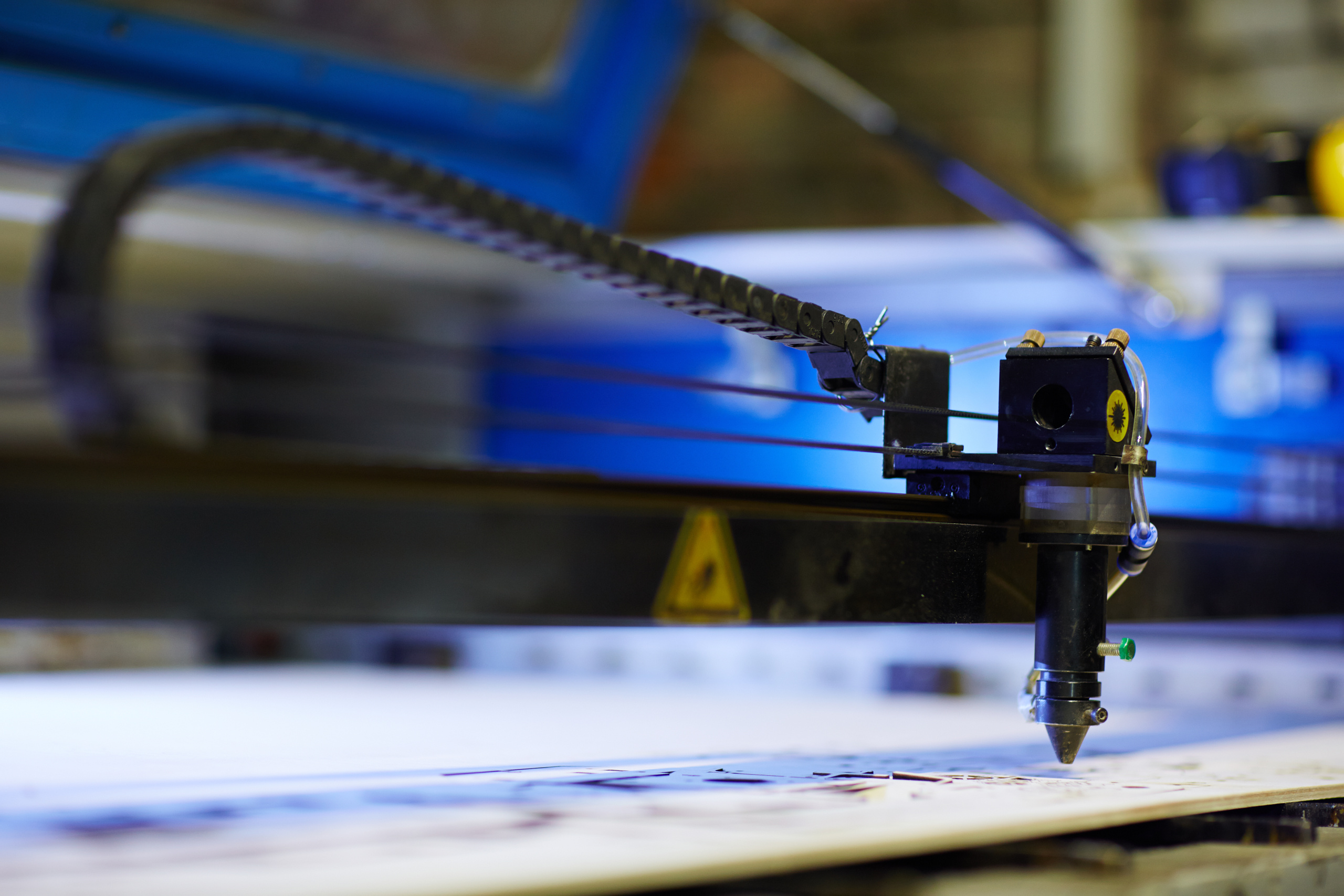What is a CNC Router, and How Does it Work?

The demands of modern manufacturing are in constant flux, driven by technological innovation, increased competition, and evolving consumer preferences. In order to keep up with these demands, manufacturers constantly find solutions to improve efficiency, precision, and versatility. An effective solution that has become a staple in modern manufacturing is CNC routers.
CNC routers are highly advanced machines capable of accurately transforming digital designs into complex parts. It utilizes computer programming to direct the tools along three-dimensional paths, creating cuts and shapes that would be nearly impossible to achieve by hand.
The level of automation and precision achieved by CNC routers is indispensable in an industry where customization and rapid production are key. Their versatility enables these industries to address various machining and production needs, whether for large-scale manufacturers or small machine shop owners.
In this blog, we delve into the world of CNC routers and discuss key topics to give you in-depth knowledge about CNC machining. Below, we answer the following questions:
- What is a CNC Router?
- What Does CNC Stand For?
- How Do CNC Routers Work?
- What is a CNC Router Used For?
- What are the Advantages of Using CNC Routers?
- What are the Different Types of CNC Routers?
- What Materials Can Be Processed Using a CNC Router?
- What are the Applications of CNC Routers?
- Do CNC Routers Have Limitations?
Find the answers to these questions and more below.
What is a CNC Router?
CNC Router Definition
CNC routers are advanced machining tools widely used in most manufacturing shops today. The term CNC stands for Computer Numerical Control, which means that these routers are operated via a computer that dictates the movement and operation of the machine according to pre-programmed sequences. These systems facilitate the precise cutting, carving, drilling, and shaping of various materials, including wood, composites, aluminum, steel, plastics, and foams.
A CNC router consists of three main components:
- Table: The flat surface that holds the workpiece securely.
- Cutting Tool or Spindle: Provides the cutting power of the machine.
- Motor: The main source of energy to drive the spindle and maneuver it along different axes for precise material removal.
All of these three components work together to provide the machine with a high level of accuracy and repeatability during machining operations. The amount of control they provide enables users to create intricate, consistent designs that are difficult to attain with manual operations.
Evolution of CNC Technology
Over the years, CNC technology has evolved significantly with the ever-changing demands of the market. Early numerical control machines relied on punched tape to dictate instructions, whereas modern CNC routers use sophisticated software and electronics.
Advancements in computer processing power, software design, and mechanical engineering have transformed these machines into highly efficient and versatile manufacturing tools.
Impact of CNC Routers on Production
The advent of CNC technology has revolutionized production capacity for manufacturers, greatly increasing the speed and efficiency with which products can be created. Unlike traditional routers that require manual operation and rely heavily on the operator’s skill, CNC routers ensure consistent quality regardless of production volumes. This shift not only saves time but also reduces material waste and the potential for human error.
How Do CNC Routers Work?
CNC routers work by moving the spindle across the work area following x, y, and z coordinates. The spindle spins at a high speed with a cutting tool, which then removes material at desired locations.
This entire process is described in the following workflow:
- Design Creation with Computer-Aided Design (CAD) Software: In this initial stage, detailed drawings of the final product are meticulously crafted, establishing dimensions, shapes, and features that the CNC router will carve out. This digital blueprint is crucial as it precisely dictates what will be produced.
- Toolpath Generation with CAM Software: CAM software translates CAD designs into machine-readable instructions, producing toolpaths that guide the CNC router bit’s movements during material cutting. These instructions detail the sequence of operations, tool selections, cutting speeds, and other critical parameters for the production process.
- Code Generation and Transfer: Once toolpaths are established, CAM software generates G-code, a language CNC routers understand, precisely defining all movements and operations. This G-code is transferred to the router’s controller, overseeing the execution of these instructions for accurate machining.
- Setting Up the Material and Tools: Before operation, the operator prepares the CNC router by securely fastening and aligning the workpiece on the worktable. Additionally, they choose and install suitable router bits and tools, taking into account factors such as material type, geometry, and desired finish.
- Running the Machine and Monitoring the Production Process: Once set up, the operator initiates the CNC router, swiftly following designated toolpaths. Continuous monitoring allows for real-time adjustments, ensuring adherence to specifications, and upon completion, the produced piece is inspected for accuracy and quality, concluding the CNC routing process.
What is a CNC Router Used For?
CNC routers, driven by computerized precision, excel in accurately shaping materials like wood, plastic, and metal. These versatile machines find application in diverse industries, from woodworking and metalworking to prototyping and sign-making. Within these industries, they are used for tasks like:
- Cutting
- Carving and Engraving
- Drilling
- Milling
- Routing
- Prototyping
- Sign Making
- Panel Processing
- Foam Cutting
- 3D Printing Molds
By performing these tasks, CNC routers streamline production processes, offering speed, consistency, and the ability to reproduce intricate designs. These are what make them indispensable in modern manufacturing and fabrication.
What are the Advantages of Using CNC Routers?
CNC routers offer a multitude of advantages for a wide range of manufacturing, woodworking, and prototyping tasks. These include the following:
- High Precision and Consistency: CNC routers can produce complex patterns and shapes with repeatability that manual operations can’t match, thereby reducing errors and waste.
- Speed and Efficiency: Unlike human operators, CNC routers can operate continuously without fatigue while achieving quicker production times. This translates to increased productivity and the ability to fulfill large orders more efficiently.
- Enhanced Safety: Automated function minimizes direct interaction with cutting tools, reducing the risk of operator injury. The operator can manage the machine remotely from a control panel, improving the production environment’s overall safety.
- Versatility: The versatility of CNC routers allows them to work with various materials, including wood, foam, plastics, and soft metals. This flexibility enables businesses to expand their product offerings and adapt to different project requirements without needing multiple specialized machines.
- Digital Nature: Designs can be easily edited and customized using computer software, offering more significant opportunities for custom fabrication and personalization that are highly valued in today’s market. This technology integration makes adapting to client specifications and scaling designs up or down a straightforward process.
What are the Different Types of CNC Routers?
The versatility of CNC routers doesn’t just end with the type of materials they can process. With a wide range of different types available, they can serve users’ needs no matter the size and nature of their CNC machining needs.
The different types of CNC routers can be categorized in many different ways, as follows:
By Size and Capability
- Desktop CNC Routers: Designed for hobbyists and small-scale projects, fitting comfortably in workshops.
- Industrial CNC Routers: Robust machines designed for heavy-duty use and are capable of handling large, thick materials in manufacturing settings. They feature stronger motors, larger work envelopes, advanced cooling systems, and precision components, allowing for continuous operation and production of intricate designs with high repeatability and speed for commercial applications.
By the Number of Axes
- 3-Axis Routers: The most fundamental type of CNC machine, offering movement along the X, Y, and Z axes for cutting and shaping materials on a flat plane. They excel in producing 2D or 2.5D objects, like decorative panels and signages.
- 4-Axis Routers: Machines that introduce an additional rotating axis (A-axis), enabling the tool to rotate around the X-axis. This capacity allows for more complex operations, such as cutting along the sides of a piece, creating cylindrical shapes, and intricate engravings.
- 5-axis CNC Routers: The most advanced type of routers, with two additional axes (A and B or C), allowing the cutting tool to approach the workpiece from any direction. This results in the ability to create highly complex 3D shapes, precision components, and smooth curves with fewer setups, making them ideal for aerospace, automotive, and other precision-demanding industries. Each step up in axis capability adds complexity, cost, and potential machining precision and creativity.
Specialized Versions
CNC routers also come in specialized versions with distinct features tailored for processing specific materials and applications. Some examples include:
- Woodworking CNC Routers: Made for cutting and engraving wood with precision; often include vacuum tables to hold materials in place.
- Metalworking CNC Routers: Designed with tougher spindles and cooling systems to handle metals like aluminum and brass.
- Stone and Granite CNC Routers: Equipped with water-cooled spindles to cut hard materials without overheating.
- Printed Circuit Board (PCB) CNC Routers: Small-scale routers for precision-milling printed circuit boards, often featuring high spindle speeds.
What are the Applications of CNC Routers?
CNC routers have revolutionized various industries with their precision and versatility. The following are some common examples of CNC router applications in some sectors:
- Woodworking: CNC routers are extensively used for cutting, carving, and engraving operations in the woodworking industry, producing intricate designs and smooth finishes on cabinetry, custom furniture, and architectural millwork.
- Metal Fabrication: In metalworking, CNC routers facilitate the precise cutting of sheet metals for industrial machinery parts, automotive components, and aerospace elements with complex geometries.
- Plastic and Foam Processing: CNC routers are critical in shaping plastics and foams for prototypes, molds, and final products in packaging, insulation, and consumer goods.
- Art and Design: Artists and designers leverage CNC routers to bring their digital concepts to life through materials like wood, acrylic, and aluminum, creating 3D sculptures, intricate inlays, and detailed reliefs.
Take Your Manufacturing Processes to the Next Level with CAMaster
Enhance your manufacturing capabilities and take your business to the next level with CAMaster. As a leading supplier of industry-leading CNC machines, we understand the importance of providing top-notch products and services to stay ahead of competitors in your industry. Our team of experts is equipped with the knowledge and skills to assist you in choosing the right CNC router for your business and provide you with the necessary support to ensure its smooth operation.
If you’re looking for a reliable partner to help you take your manufacturing capabilities to the next level, look no further than CAMaster. Contact us today to learn more about how we can help your business grow.
Want to upgrade your CNC workflow?
Discover our industrial-grade CNC solutions tailored to your needs. Learn more →















